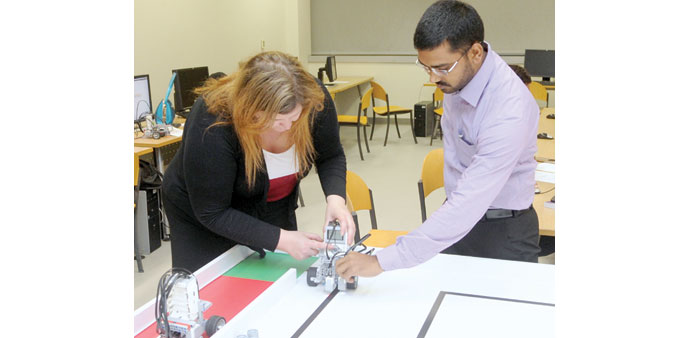THE STRAIGHT AND THE NARROW: A CNA-Q staff, left, trains a teacher to programme a robot to walk in a straight line.
Bringing world’s finest emerging talents in robotics to Doha will significantly fuel the country’s young minds to think better and strive harder to excel, Dr Theodore Chiasson, Dean of Information Technology at CNA-Q, tells Anand Holla
With little robots by their side, teachers from various schools of Qatar sit in rows in a bunch of classrooms. Like eager students, their eyes are fixated on their computer screens beaming a visual programming language defined by dragging and dropping large blocks in a sequence. With every move they make, they learn something new — all the accumulated wisdom bolstering the robotics programming arsenal of their school’s team.
At the College of North Atlantic-Qatar (CNA-Q), such a sight has been rather constant during most evenings over the last few months. Hundreds of science, technology, engineering and maths teachers have been undertaking intensive training in the use of robotics programming, in preparation of the grand annual championship of ingenious gadgetry.
Dr Theodore Chiasson, Dean of Information Technology at CNA-Q, who flits in and out of classrooms labelled on the outside as anything from Level 1 to Level 8, so as to oversee the progress, says, “We offer 30 hours of training for teachers, which are essentially 10 three-hour sessions. So the teachers come on 10 different evenings on their own time to learn about the robotics, and the uptake has been larger than ever.”
In preparation of first, the Qatar National Robot Olympiad (QNRO) finals scheduled for October 30 and 31, and then the ginormous 12th World Robot Olympiad (WRO) 2015 — featuring 3,000 of the world’s best robotics students from Qatar and 55 other countries — which Doha, for the first time, will host from November 6 to 8, a flock of teachers have been busy demystifying complex robotics theories courtesy CNA-Q’s Information Technology faculty.
With just three evenings of classes left before the end of training and with most teachers having attended the necessary hours of lectures, the numbers attending the sessions has trickled down. Yet, as we take a dekko, a deep sense of motivation is palpable among the handful that is present.
“Earlier in June, we held a graduation ceremony for 150 teachers that had completed all of the 30 hours of training. And then, there are another 150 teachers who are now at different stages in the training. So we will train more than 300 teachers this year,” Chiasson says, moments before he enters one of the classes in progress.
Of the four classes underway, one has teachers figuring out how they must check their sensors’ reading as their robot waits for an event. “It’s called polling,” Chiasson says in a hushed voice, looking at the class from a corner, “Your robot checks for another event before doing something else. The robot can’t do anything until the event occurs.”
If that sounds complex, it’s because it is. And expectedly, with each level, the difficulty level heightens. In the classroom teaching Level 8, for instance, an instructor is helping a teacher make his robot do specific tasks like following a line and turning or picking up an object. “The robot must start here and follow the line until it is here and detect the cross here,” a lady instructor explains, pushing a robot on a game table, “It must know to skip this line and find its way back.”
Established in 2012 by Maersk Oil Qatar in partnership with CNA-Q, the QNRO is essentially the culmination of the year-long school robotics programme, GO ROBOT, which seeks to boost students’ interest in STEM subjects. Maersk Oil Qatar says that the programme reflects its business’ sustained efforts to encourage greater participation in STEM subjects in Qatar. Among other benefits, the study and use of robotics kits by high school students has been shown to improve problem solving and creativity as well as team working skills.
Aided further by the Supreme Education Council’s endorsement and Qatar Petroleum, too, signing on, the QNRO that saw just 30 coaches in 2011 had 400 teachers attending the training last year.
Lego Mindstorms, a full-fledged robotics kit, is the choice of equipment for showcasing this automated wizardry. The range of design possibilities with a whole kit plus an expansion kit is mind-boggling. It all begins with Level 1 which involves uncovering a new kit, building the robot as per the manual, learning the bare bones of programming and getting accustomed to the interface.
“Teachers often tell me that they have been teaching robots for five years but they had never actually done it, you know, put the pieces together. I think it’s very important to get that hands-on experience,” Chiasson says, “In elementary schools, your robot usually must push things around or drop things. When the students are 13 or 15, then their robots should be able to pick things up. In High School, the robots should be able to place things very carefully. So it certainly gets progressively harder with each level.”
There’s no way to bluff on the big day. If a student hasn’t understood the ins and outs of his or her robot’s programming, failure is imminent. “During the competition, they will have to slightly change the robot’s programming to score all the points. In that sense, they may have to build the robot from scratch. Students, who don’t understand how these changes work, will get stuck,” Chiasson cautions.
This year, CNA-Q has also introduced new training on a category called GEN II Football, which features two robots from each team battling it out on a large football game table. “Last year, we had three, three-hour sessions. But we have revamped it to five three-hour sessions because for the GEN II Football competition, in order to build a robot and compete in it, you really need the 30 hours plus another five sessions,” explains Chiasson, adding that 18 teachers have taken this complete training.
To facilitate a wider reach of these benefits, CNA-Q, this year, has introduced the whole training sessions in Arabic as well. “Many teachers in the public school system didn’t find it accessible to take the lessons in English,” Chiasson says, “So I hired two teachers who have, for years now, performed very well in the QNRO finals and have gone to the WRO finals as well with their teams. They have translated the materials and are delivering these sessions in Arabic.”
While last year’s QNRO finals saw 217 teams in Qatar, 380 teams have signed up for this year’s event. Chiasson believes bringing world’s finest emerging talents in robotics to Doha will significantly fuel the country’s young minds to think better and strive harder to excel.
“When nearly a dozen top teams of Qatar went to various WRO finals, their appreciation for the level of competition of the WRO finals grew,” Chiasson points out, “For instance, one team here solved the challenge completely in 1.10 minutes when they had 1.20 to solve it. They thought they had done well. In WRO finals, the top team solved it in 45 seconds. So it really opens their eyes to what can be done with robotics. Bringing WRO to Doha is, therefore, a great step ahead.”
Since 2012, the GO ROBOT programme has reached more than 8,000 students in Qatar and more than 1,000 teachers have participated in robotics training sessions. In addition, GO ROBOT has distributed more than QR1 million worth of kits to teachers and schools. More than 500 robotics kits were distributed to teachers last year along with more than 180 robotics games tables.



